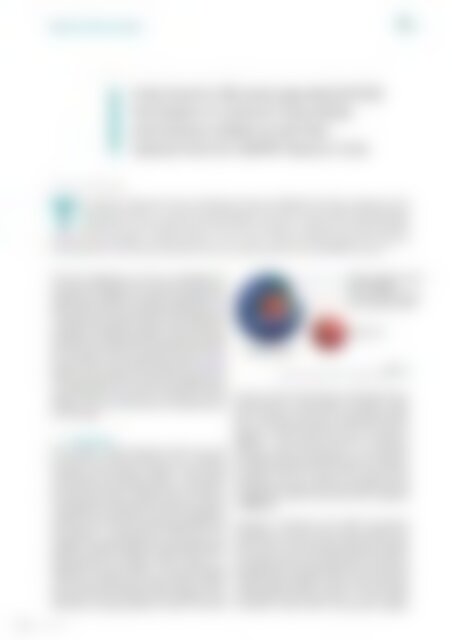atw - International Journal for Nuclear Power | 2.2024
Internationale Entwicklungen und Trends
Internationale Entwicklungen und Trends
Create successful ePaper yourself
Turn your PDF publications into a flip-book with our unique Google optimized e-Paper software.
Research and Innovation<br />
67<br />
Fully Ceramic Microencapsulated (FCM)<br />
fuel based on Uranium Oxy carbide<br />
and Uranium Nitrite as the fuel<br />
replacement <strong>for</strong> SMART Reactor Core<br />
› Khurram Mehboob<br />
The system Integrated Small and Modular Reactor (SMART) has been designed with<br />
conventional fuel or uranium dioxide (UO2). The Fully Ceramic Microencapsulated<br />
(FCM) fuel as an Accident torrent fuel (ATF) provides a multitude of safety benefits<br />
where the fuel length is deprioritized. In this work, uranium Nitrate (UN) and uranium<br />
oxcarbide (UCO) have been replaced with the conventional fuel <strong>for</strong> the SMART reactor.<br />
The fuel replacement has been investigated <strong>for</strong><br />
criticality with depletion (burn up), fuel and moderator<br />
temperature coefficients, and power peaking factor<br />
despite the alternation of assembly configuration. The<br />
UN and UCO as Tirso Particle fuel in FCM configuration<br />
are implanted in graphite matrices. Nitrite fuel has the<br />
advantage of mechanical stability, enhanced thermal<br />
conductivity, and high fuel density compared to dioxide<br />
fuel (UO2). The neutronic assessment of UN and UCO<br />
<strong>for</strong> the SMART reactor examined the effective multiplication<br />
factor, thermal flux distribution, axial and<br />
radial power distribution, and power peaking factor<br />
at the beginning, and end of the fuel length. Results<br />
indicate that the UN and UCO as FCM fuel are more<br />
feasible in terms of safety with the compromising of<br />
the fuel length.<br />
1. Introduction<br />
Fully ceramic microencapsulated (FCM) fuel with<br />
an improved accident tolerance due to oxidation<br />
resistance, fission product retention, high thermal<br />
conductivity, and irradiation stability [1–4] has revealed<br />
much attention as the Accident Torrent Fuel (AFT) <strong>for</strong><br />
the Light water Reactors (LWRs). Since the FCM provides<br />
significant safety benefits. There<strong>for</strong>e, it presents<br />
a dilemma <strong>for</strong> the FCM fuel concept <strong>for</strong> the SMRs as it<br />
has been envisioned as the transuranic-bearing TRISO<br />
fuel particles [5–6] . Historically the TRISO fuel is developed<br />
<strong>for</strong> the High-Temperature Gas-cooled Reactors<br />
(HTGRs), or spherical pebble of a pebble bed modular<br />
high-temperature gas-cooled reactor operate at a<br />
temperature in excess of 1000C [7] . The aim of designing<br />
FCM fuel is to improve the fission retention capacity<br />
and to withstand during the accident process. FCM is<br />
composed of the Tri-isotropic fuel embedded in the<br />
fully dense and impermeable SiC matrix. The TRISO<br />
Fig. 1.<br />
Structure View of the Triso-coated Fuel Particle [9]<br />
particles consist of a fuel kernel encapsulated by three<br />
coating layers of carbon buffer, a pyrolytic carbon<br />
layer, a SiC layer, and a dense outer pyrolytic carbon<br />
layer [8] whereas the kernel is an oxide fuel of nitrates,<br />
carbides, or fissile material (U, Pu, Po) as shown in<br />
Figure 1 [9] . The concept of FCM fuel is to develop a<br />
fuel pallet similar in dimensions to a conventional<br />
fuel pellet that could be loaded in fuel rods. However,<br />
the FCM fuel pellet triso fuel particles are randomly<br />
embedded in the SiC matrix. The analogy of the<br />
conventional fuel pellet and FCM fuel pellet is depicted<br />
in Figure 2a [9] and the cross-section view is compared<br />
in Figure 2b.<br />
FCM fuel is composed of the TRISO fuel particles<br />
embedded in the fully dense silicon carbide (SiC)<br />
matrix. The SiC matrix can <strong>for</strong>m the radiation-resistant<br />
<strong>for</strong>m of SiC of a near theoretical density at relatively<br />
low applied pressure and temperature. This mild sintering<br />
prevents the de<strong>for</strong>mation of the SiC layers and<br />
minimizes the consumption of OPyC. The Tri structuralisotopic<br />
(TRISO) particle consists of the fuel kernel<br />
surrounded by four successive layers [10] of PyC, and SiC,<br />
low-density carbon buffer, and pyrolytic graphite<br />
Vol. 69 (2024)
















